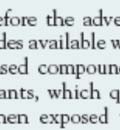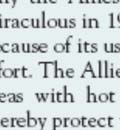Baird_ch10_web.qxd








baird_ch10_Web.qxd 8/25/07 3:54 AM Page 2
To Ban or Not to Ban DDT ? Its History
and Future (continued)
worm control) and in forestry. Unfortunately,
with a vengeance, and half a million cases of
DDT was widely overused in the 1950s and
malaria per year were being reported. In the
1960s in agriculture, which consumed 70–80%
interval, DDT was still being used on crops,
of its production, and in forestry. Eventually,
and as a result, many of the local mosquitoes
some insect populations became resistant to
had acquired resistance. So, when spraying
DDT and its effectiveness decreased. This phe-
with DDT against malaria was begun again, it
nomenon led some farmers to apply greater and
was much less effective than before. Malathion
greater amounts of the insecticide, particularly
was then used effectively for several decades to
on cotton fields. Peak usage in the United
again reduce the incidence of malaria in Sri
States occurred in 1959 (over 35,000 tonnes),
Lanka, but recently some mosquitoes have
and declined gradually over the 1960s to one-
become resistant to it as well, so pyrethroids
third of the peak by 1970. In the early 1970s,
are now being used instead.
most of the remaining agricultural use of DDT
The Sri Lankan case illustrates a general
was on cotton crops. Overall, more than 600
tension in DDT use that has arisen in several
hundred million kilograms of DDT were used in
developing countries. Although now illegal by
the United States alone, and more than 1 bil-
the U.N. convention, massive spraying of crop-
lion kilograms worldwide.
land by DDT was used in agriculture to combatinsects that destroy valuable harvests. In addi-tion to adding to the global reservoir of DDT
DDT and Malaria
circulating in the air, however, such widespread
In the United States, Canada, and Europe,
use promotes the development of resistance
malaria had been largely eliminated by the
by the mosquitoes to DDT in the local area.
early twentieth century by public health meas-
Consequently, the (legal) use of much smaller
ures, but DDT played a role in its final eradica-
amounts of the insecticide to combat malaria is
tion in mid-century. However, malaria was still
rendered largely ineffective, because the mos-
endemic in many hotter, developing countries.
quitoes are resistant to it. Although in 1969 the
For that reason, the World Health Organiza-
WHO abandoned the goal of completely eradi-
tion in 1955 initiated a program to eliminate
cating malaria, they have continued efforts to
the disease worldwide, relying heavily on DDT.
control and treat the disease.
Although the program initially was very suc-
The use of DDT never proved particularly
cessful in many parts of the world, eventually
successful in tropical areas where mosquitoes
insect resistance to the insecticide emerged.
are present in all seasons. The WHO program
For example, from 1934 to 1955, Sri Lanka
did not come into force in sub-Saharan Africa,
(formerly called Ceylon) averaged 75,000 cases
and consequently malaria continued there
and 4,000 deaths annually from malaria. Fol-
unabated. Unfortunately, resistance of some
lowing an extensive campaign based upon
forms of malaria has developed to anti-
DDT, the number of cases had fallen to only 17
malarial drugs, the most prominent of which is
in 1963. The antimalarial campaign was then
chloroquine. The plasmodium falciparum para-
halted, but by 1968, the disease re-emerged
site, which now accounts for 80% of infections
baird_ch10_Web.qxd 8/25/07 3:54 AM Page 3
and which is more prevalent in sub-Saharan
According to the U.N.'s recent Stockholm
Africa than elsewhere, produces a type of
Convention on Persistent Organic Pollutants
malaria that is the most dangerous in terms
treaty discussed in the text, countries can
of complications and mortality, causing 90% of
request to continue using DDT against malaria
the mortalities from this disease. It is resistant
until effective and affordable alternatives
to chloroquine and most other drugs in Africa,
become available, and more than two dozen
India, and southeast Asia.
countries—mainly in sub-Saharan Africa—have done so. Although some environmental
Bans on DDT
groups have pressured the U.N. to include a
The American public became aware of the
total ban on DDT, others have been strongly
environmental problems associated with DDT
opposed to a complete ban, given that it so
upon the publication in 1962 of Rachel
effective in small amounts against malaria, a
Carson's book, Silent Spring. In it, she discussed
disease which kills 1 million children annually
the decline of the American robin in certain
in Africa and whose incidence is increasing.
regions of the United States, due to its con-
(Children under five years of age are much
sumption of earthworms laden with DDT used
more susceptible to mortality from malaria
in massive amounts to combat Dutch elm
than are teenagers and adults. However,
disease. Carson's book stimulated widespread
poverty, malnutrition, diarrhea, and respiratory
public concern about the insecticide.
disease still are responsible for most infant
The U.S. Department of Agriculture can-
mortality in sub-Saharan Africa.) The solid
celled most uses of DDT in 1969 and 1970.
residue on surfaces such as indoor walls after
Following months of hearings, the U.S. Envi-
spraying with the insecticide provides months
ronmental Protection Agency cancelled all
of protection against mosquitoes. Groups
remaining uses except for vector-borne disease
opposing a ban argued that the health hazards
and body-lice control, effective in early 1973;
of DDT to humans are miniscule compared to
all remaining uses were cancelled in 1989.
the great benefits it can provide. Switching
Canada followed a similar timeline. DDT was
to alternatives would probably be beyond the
banned in Norway and Sweden in 1970, in
financial means of many poor countries, and
most other developed countries in the 1970s,
would require more frequent applications since
and in the United Kingdom in 1984.
other insecticides are not as persistent, and
Although many of the general public
alternatives are usually more acutely toxic. As
believe DDT was banned because of its harm-
a consequence, several African countries have
ful effect on human health—Rachel Carson
lifted their bans on DDT use and have reintro-
having stated in her book that it caused
duced it for malaria control—for example,
human cancer—there was and still is very
South Africa, where mosquito resistance to
little evidence to support that claim. The sci-
pyrethroids developed—and others are debat-
ence supporting the bans is based mainly on its
ing the issue. Indeed, in 2006, the U.S. Agency
effects on wildlife, such as bald eagles, as dis-
for International Development, a major
cussed in Chapter 12 of the text.
donor agency, reversed its previous policy and
baird_ch10_Web.qxd 8/25/07 3:54 AM Page 4
To Ban or Not to Ban DDT? Its History
and Future (continued)
endorsed the indoor spraying of DDT for
control measures together are effective in
malaria control, and the World Health Organi-
mosquito control.
zation followed this lead the same year.
Recent research on the effects to humans
The global amounts of DDT that would be
of high-level exposure to DDT, as occurs when
employed for indoor spraying to prevent dis-
houses are sprayed with it for malaria control,
ease would be tiny compared to the quantities
has centered its effects to newborns and to
used in the past for agricultural purposes, and
women of child-bearing age. In particular,
which to some extent are still present in air,
there is a correlation of blood DDT levels
water, and soil around the world. However,
with early loss of pregnancy. Also, exposure of
people living in the sprayed homes and adjoin-
the mother to high DDE levels in the first
ing areas would be exposed to significant levels
trimester of pregnancy may produce children
of the chemical. There is some social resistance
having some psychomotor development prob-
to effective indoor spraying, because DDT pro-
lems in their first year of life. Although some
duces stains on walls, which residents then
studies indicated that exposure to DDT and
clean or replaster, thereby removing or cover-
DDE gave rise to premature delivery and small
ing the insecticide. Experience in the past has
birth weight, a recent analysis of births during
shown that DDT spraying is most effective in
the 1960s in the United States to women who
reducing malaria in highland areas, and regions
had high levels of DDE does not support this
where mosquitoes and disease occurrence is
conclusion. High levels of DDE present in
occasional or seasonal rather than endemic.
breast milk have also been associated with a
Groups supporting a total, immediate ban
reduced period of lactation, which could
have argued in the past that some countries
potentially increase the rate of infant mortal-
such as Mexico have eliminated malaria with-
ity in developing countries.
out the use of DDT, and that the mosquitoesresponsible for carrying most of the disease are
already resistant to DDT in parts of the world
1. Why do you think DDT is such an
such as India. Another argument against
allowing spraying of DDT against disease is
2. Develop three-minute debate-style
that it can interfere with pregnancy, and
speeches (a) in support of a total ban on DDT,
might affect the health of newborns, as dis-
and (b) in opposition to banning DDT for use
cussed below. In addition, studies indicate that
in disease control.
more than 80% of the DDT sprayed indoorseventually evaporates and escapes outdoors,
3. The agricultural sector in some developing
where it adds to the pool of the insecticide cir-
countries opposes the use of DDT for malaria
culating globally in the atmosphere. Groups
control because they fear DDT residues will
proposing a total ban on DDT point out that
increase on food that they produce. Do you
bednets soaked in more eco-friendly insecti-
think high DDT levels on produce would
cides and environmentally friendly pest
affect their international sales?
Source: http://online.universita.zanichelli.it/baird3e/files/2013/07/Ch10_To_Ban_or_Not_to_Ban_DDT_Its_History_and_Future.pdf
Hydroxyurea clinical practice guidelines - providers - first choice by select health of south carolina
Tips and guidelines for prescribing hydroxyurea. Clinical Practice Guidelines • 15mg/kg daily for adult patients with normal kidney function. • 5-10mg/kg daily for adult patients with creatinine clearance (CrCl) <60 mL/min. • 20mg/kg daily for infants (>9 months) and Baseline laboratory values • Complete blood count (CBC) with differential.
coloplast.co.uk
Diabetic foot ulcers – prevention and treatment A Coloplast quick guide Biatain® – the simple choice Diabetic foot ulcers have a considerable negative impact on The diabetic foot – a clinical challenge . 5 patients' lives, and are highly susceptible to infection that al too Pathway to clinical care and clinical evidence . 6 often leads to amputation. It is essential that diabetic foot ulcers